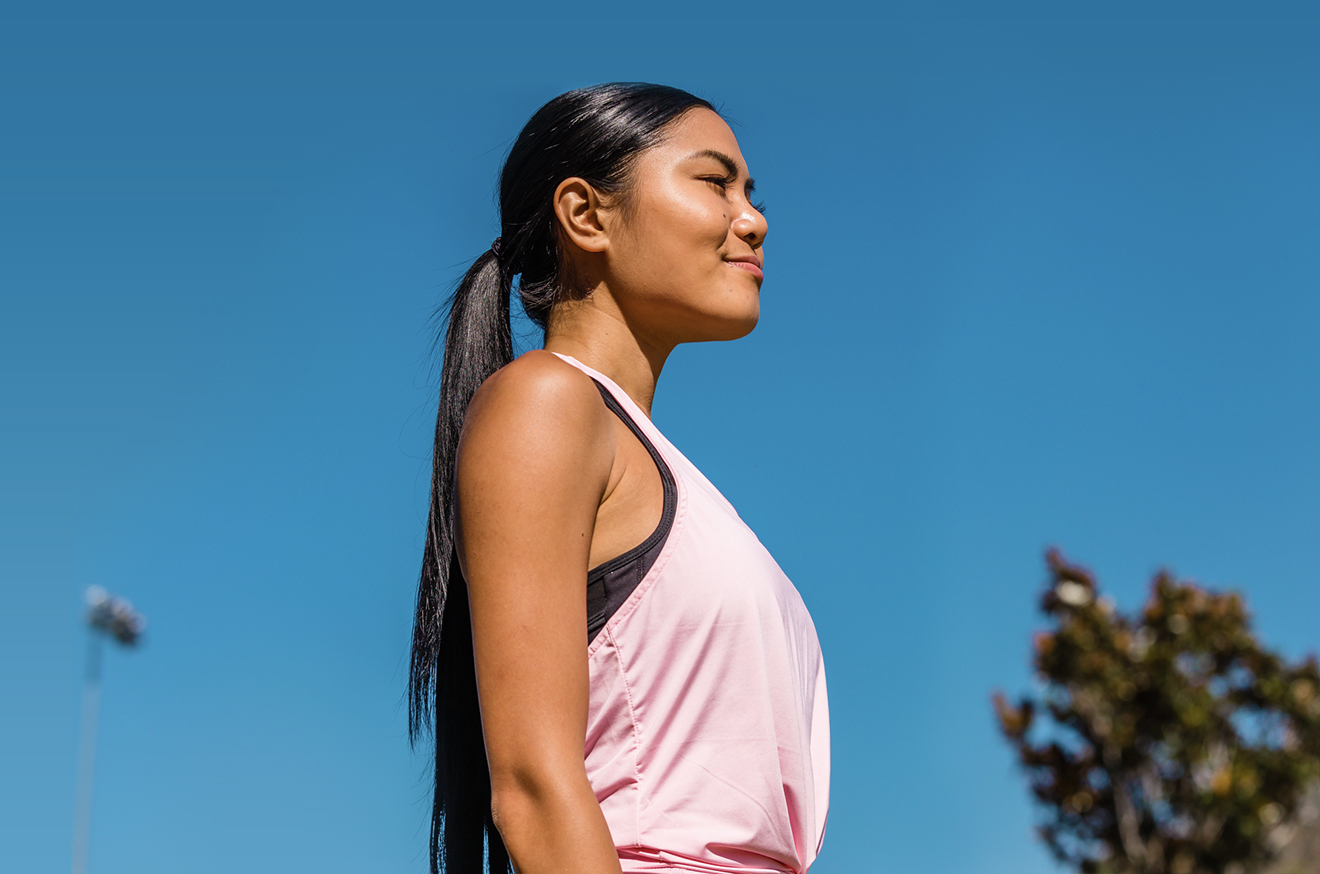
This post will help you learn how to have great posture.
For starters, imagine that your pelvis, ribcage, and head are like a child’s wooden playing blocks. Are they level and aligned? Does their positioning set you up nice and tall, or crush and grind?
Collapsed posture compromises the alignment of your bones from the center to the periphery of your extremities. This impacts the quality and efficiency of your movement, breath, digestion, circulation, and elimination. It often leads to uncomfortable muscular imbalances.
To better understand how to generate excellent posture, here are some details on your spine you should know.
Know Your Spinal Curves to Get Great Posture
The spine has five natural curves. The cervical (neck) spine curves toward the front of the body, the thoracic (ribcage) spine curves back, the lumbar (lower back) spine curves forward, the sacrum lifts slightly back, and the coccyx (tailbone) tucks slightly forward as well.
Have a look at the image on the right–this is a side view of your spine.
Now self-reflect: Is your spine curvy or does it have flat spots? Look at yourself sideways in the mirror. Or better yet, ask someone to take a picture of you.
Stand as you normally do, so the camera doesn’t lie! Then realign your ‘blocks’ (pelvis, ribcage, and head) to stand as upright as possible. Take another picture. How does this more aligned posture look and feel?
To check posture from the side view, a plumb line is often a good way to see what’s happening. Ideally, the center of the side of the ear should line up with the center of the sides of the shoulder, hip, and ankle.
Physios and athletic therapists often assess a patient’s posture using this simple visual.
Poor Posture Cues from Childhood
What are we so often told about posture when we’re young? Stand up straight, don’t slouch, and keep your shoulders back! These cues are easily misinterpreted.
For example, if you always pull your shoulders back, you may be creating tension in the upper back. Instead, I like to imagine that the outer points of my shoulders are supported evenly as if resting on a clothes hanger.
As they rest, they spread outward, widening the clavicles (collarbones) and making space between the scapulae (shoulder blades).
Spinal Massage and Mobility Exercises for Great Posture
Now let’s take a look at some rolling techniques on a Coregeous® sponge ball for improving your posture.
Posture Technique #1: The Neck (Cervical) Spine
Lie down on your back with your knees bent, feet on the floor. Imagine that you have taken that tower of a child’s building blocks and carefully laid it down without changing the relationship between the blocks.
Place a Coregeous® ball behind your head at the base of your skull. This is called the occiput.
Breathe deeply and slowly while releasing the weight of your head into the soft support of the ball. You might want to adjust how much air is in the ball; less is better for this.
After about a minute, slowly nod your head “yes” while inhaling as you lift the chin, and exhaling as you lower it. Do this 5-10 times. Whenever I do this I say, “Yes! I love to care for my spine!”
Now slowly move your head to one side as you inhale, back to the center as you exhale. Alternate slowly to each side. This is where I say “No! I don’t like pain.”
Come back to rest in the center and notice if your neck feels longer. You may have just opened up a little space in your cervical spine!
Remove the ball and rest for a few moments.
Posture Technique #2: The Sacrum and Lower Back
Gently place the ball under your sacrum. Once again, simply allow your bodyweight to release into the ball and breathe deeply for one minute. Locate two points of anatomical reference–your sternum (breastbone) and the pubic bone.
Inhale and lengthen the space between these two points by arching to a gentle back extension with an anterior tilt of the pelvis. Exhale, draw those same two points closer together curving into small spinal flexion with the pelvis in a posterior tilt. Repeat 5-10 times.
Rest for a few breaths and then gently move sideways (right to left) 5-10 times. Let the ball give you a soothing massage on the lower back and hips.
Lift your hips just enough to remove the ball and notice how your lower back feels.
Posture Technique #3: The Ribcage and Thoracic Spine
The thoracic (ribcage) spine is an area that is naturally less mobile than the neck or lower back because it is attached to the ribcage.
It is also an area that gets tight and sore from a variety of activities: sitting, lengthy computer time, cell phone usage, driving a car, carrying babies, or having an occupation such as dental hygiene, cooking or hairstyling that requires bending forward.
Over time this can negatively affect your bones, soft tissues, and breathing.
Here’s a great way to loosen up your thoracic (or ribcage) spine.
Nestle the Coregeous® ball under your upper back, between the shoulder blades. Lay on the floor, knees bent, feet touching the ground. Interlace your hands to support your head.
Breathe while feeling your ribs expand on the inhale and release on the exhale in all directions for one or two minutes. Next, slide up and down on the ball a few times, by pushing into your legs and feet.
Then, try sliding sideways across the ball.
Here’s one more that I love! Inhale and gently arch your back, exhale and do a mini abdominal crunch.
Now remove the ball and again, simply rest on the floor, sensing what has changed.
To finish, stand up and practice your upright posture once again. Is it easier to “stand up straight” now?
I hope that these practices will help you free up all those tight tissues, breathe better and put you on the path to better posture for a lifetime!
Shop this post: To practice the back mobility exercises get the Coregeous® ball.
Related Article: Healthy Aging Through Sustainable Fitness: A 4-Pronged Approach
Learn more about our Therapy Ball Products and Programs
Interested in video and blog content targeted to your interests
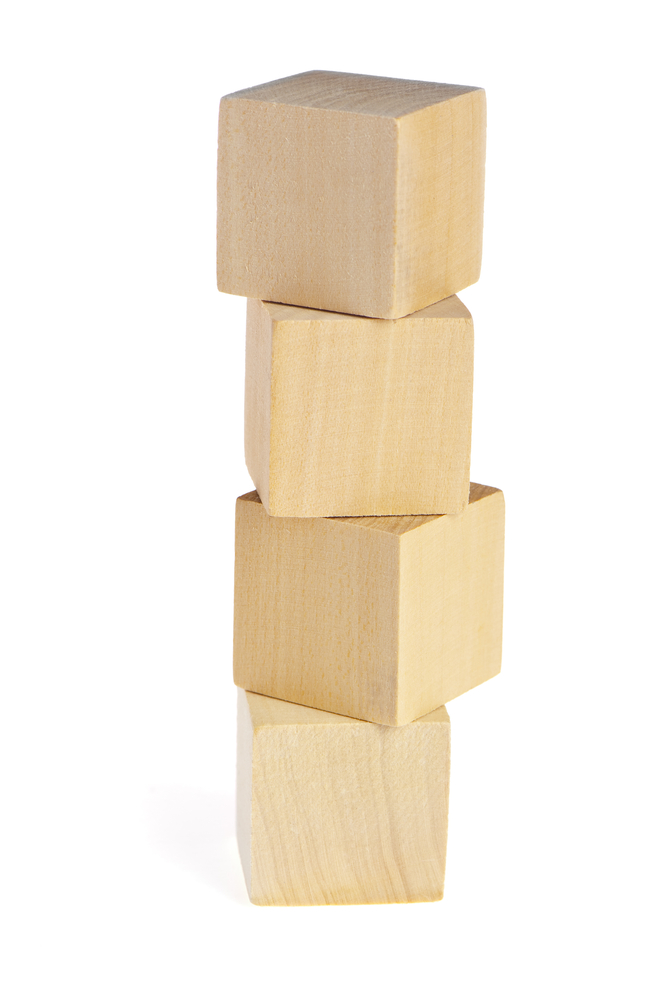
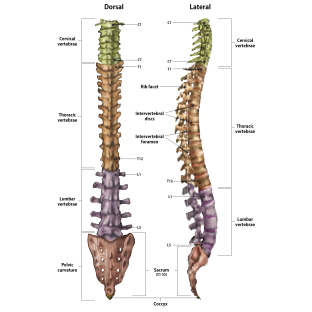
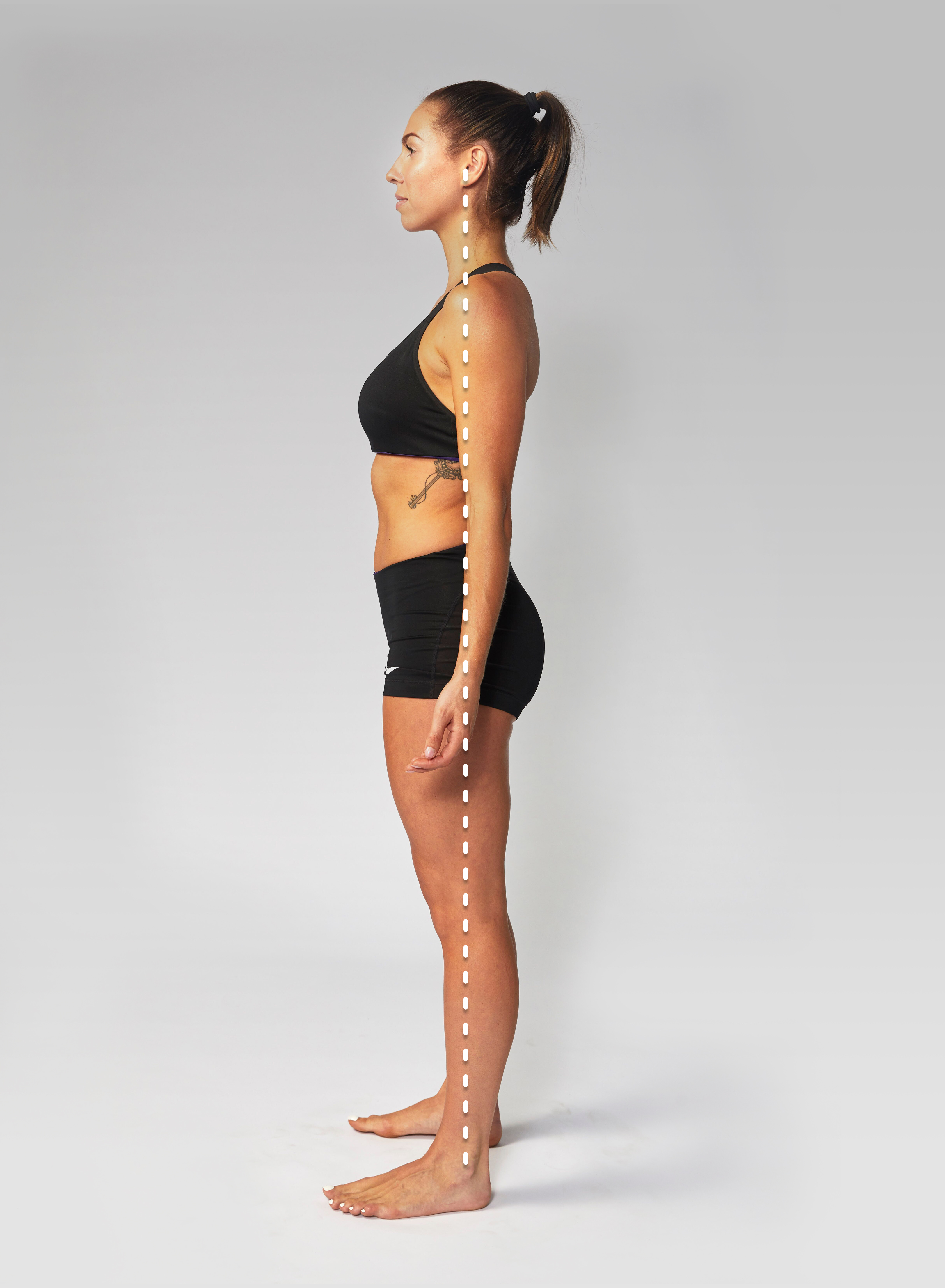
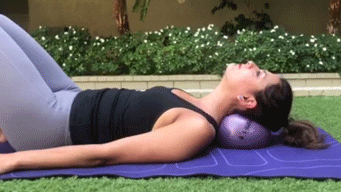

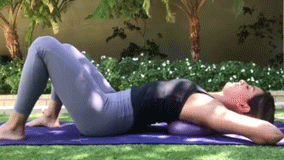
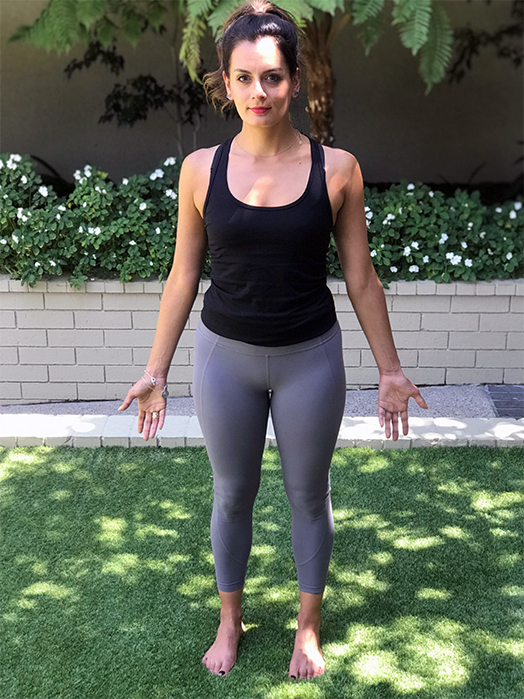


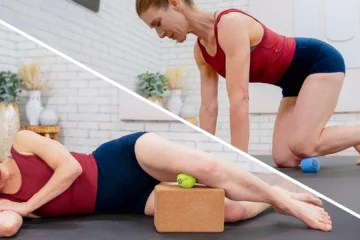
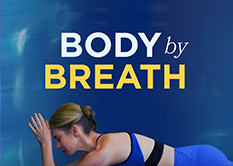



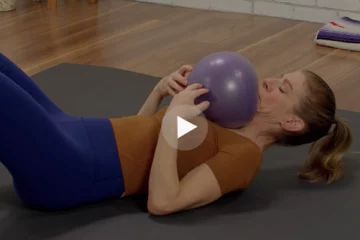
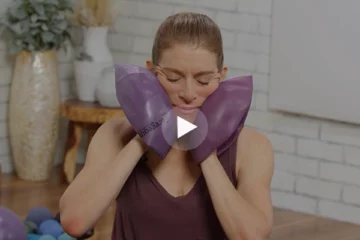


I recently purchased a coregeous ball and was really helped by your exercises. I like how you shared the natural spinal curves so that I can think about them as I stretched on the coregeous ball. It was effective to do 3 seemingly simple but effective exercises with the coregeous ball.
The exercises with the Coregeous ball sound like a nice way to both relax and fix those everyday slumps we all fall into. It’s funny how we spend so much time hunched over screens and then wonder why our backs hurt. Definitely going to try these tips to see if I can straighten up and feel better doing it!
Yes! When I was a kid I thought that good posture meant thrusting your chest out! That always felt awkward to me and now I understand why. I love that we can always work on posture, matter where we are! I took my deflated Coregeous® ball with me on a recent flight and as we took off I inflated it and (subtly) sheared my whole back. Then I moved it around my back to support my posture throughout the flight. Instead of feeling crickety and achey at the end of the flight, I felt like I had gotten a massage (I had)!
It’s interesting how everyone interprets cues differently and how it really can be taken as an extreme or to an end range and we don’t often think of that. And to think that the reality of that shows up as we impart things to children and to our students and whoever we come in contact with, it’s still their interpretation. I like the way this kind of made it clearer to think about it differently and how it can kind of drift off in the direction that might not be supportive for the person as they’re also trying to understand and feel out in their body what you are stating.
It’s also good to remember how much the breath can impact your release and how you live in your body. These exercises were really good to help make those connections with aware we’re feeling attention. We’re holding stress and also just bringing more awareness to the body.
The analogy of thinking of my shoulders as a hanger stretching out to the sides rather than being pulled back for good posture blew my mind just now! Absolutely amazing cue which I will be using during classes I coach. It’s so interesting how our posture affects so much more than just the anatomical position of our bones. The muscles and fascia throughout the body can become tight, limited, and weak by how we stand. Our digestive system can become hindered by the squishing of certain organs with how we are carrying ourselves over the years. I cannot wait to try out all of the movements with my coregeous ball to see how I can improve my own posture day to day.
I am going to incorporate these exercises into my yoga practice today! Poor posture and repetitive strain injuries brought me to yoga and eventually to the Yoga Tune Up and Roll Model Method systems and I need to do these things regularly to stay “Tuned Up!”
As I read the paragraph on age old posture cues it brought back many memories of being told to stand up straight as a young kid. When I thought of posture then I would elevate my chest, ribs splayed out to the front, chest almost at my chin. “Stack your bones like blocks” would have been a much more useful and effective visual! Thank you for sharing.
Great insight and helpful exercises using the coregeous ball to get your posture back in alignment. I could tell a difference before and after in my body sensing and standing posture. The wooden block stacking imagery is helpful with posture alignment. I’ll be sure to pass this along. Thank you for sharing.
I like the point about not just puling the shoulders back to stand up straight, but resting them as on a clothes hanger. I think that imagery is helpful because so often I see “corrections” to poor posture that aren’t solving the issue, they just seem to bring into proper alignment without actually doing so or even creating more problems. It’s so much about the awareness and proprioception so giving people tools like the Corgeous ball and the sensation of release can help people self-correct in a way that actually helps!
What a great sequence for building breath awareness and freeing up commonly stuck areas in the body. I definitely stood up taller afterward with a deepened sense of grounding. Thanks Jasmine!
Not only do I need these exercise, but my coworkers and clients do, too. Most of us are definitely suffering the effects of bad posture these days, especially from too much sitting. I am most interested in trying the thoracic spinal extension with my clients.
Étant en formation YTU, j’ai pris davantage conscience de ma posture. Je suis souvent en analyse de ma posture dans différents contextes. Les exercices proposés dans cette article seront ajoutés à ma routine afin d’avoir la meilleure posture anatomique.
Merci pour ces trucs simple et facile à intégrer dans ma routine quotidienne. Une bonne posture est la solution a bien des maux.
Une routine simple à réaliser pour améliorer sa posture. Merci!
Looking forward to reading your blog posts.
Those spinal reset using Coregeous ball is my jam. I always start my personal practice in constructive rest position and do simple breathing practice with Coregeous at different positions along my spine.
We are here at the YTU training and do a lot of sitting, writing and absorbing. I’ve felt my posture a little hunched and in different positions than my normal routine so this coregeous ball sequence felt really good. In the plumb line picture I took of myself this morning, my head was forward. After the sequence it was much closer to the line which lets me know I may need to repeat that neck part more often! Thank you for such a wonderful and simple posture helper.
This is everything I have been needing to discuss with my twenty something daughter. She will love this. The way all of these exercises can be gentle and yet vibrantly effective is so exciting. I can’t wait to see how my daughter’s posture improves!
It’s amazing how gentle exercises at the cervical, thoracic and lumbar spine can lead to easier and more efficient movement in the body. I really resonate with what you said about posture and learning from what we were taught when we were young. I can’t tell you how many people I come across who retract and elevate their shoulders to stand up straight only to cause cervical pain. Great simple and gentle exercises. Can’t wait to try them out!
Lovely, gentle exercises to gain proprioception of the spine and improve posture. Can’t wait to try these!
I will put those in my dayly routine. Thank you
Merci, j’avais pas encore fait d’exercice avec le ballon coregeous. Très intéressant l’idée de la photo.
Posture affects our mindset, our digestion, our muscles and so much more. I will share these exercises with those around me because many need them
Thanks for the tip that the edge of the ear should be lined up with our ankles, and that rolling with a corgeous can actually help our alignment! I also didn’t know that our spine had 5 curves wow!! Thanks for the tips
I never made a link between digestion, circulation, elimination AND posture. Interesting to learn.
I love the discussion of the 5 curves of the spine. It can be challenging to find a neutral standing posture without overcorrecting. Thanks for the tips!
I love the child’s blocks description for spinal alignment, great visual.
I use these exercises on the Coregeous ball as a warm up for my clients, especially ones with neck and low back issues. Its a nice starting point for a good workout.
Love the gentleness and non threatening nature of the Coregeous ball. Less is more! Thank you for this!
I absolutely loved the brief anatomy overview that was put in laymen’s terms. So important to educate ourselves on our own bodies to better understand how to make postural adjustments. The rolling techniques coupled with breathing were such a great guide into how to access more space in the spine. So much tension, personally for me, builds up throughout our day and various environmental stressors (aside from the pressure of gravity as we move about our day), only compound the issue of posture and carrying ourselves in alignment throughout each day. I appreciate that the cervical spine was included with exercises. So many practitioners eliminate the neck. Priceless information on how to work with rolling the cervical spine. Our society needs this information! We are practically balance our bowling ball of a head on a straw of a neck all day.
These are great tips! Looking forward to incorporating them into my daily practice!
This is a wonderful reminder that creating that fluidity in your spine simply takes a few minutes a day with the right equipment.
Thanks for the building block analogy, and for recognizing that our childhood postural cues (mine included my grandmother’s thumb in the middle of my back) don’t always set us up for ideal posture. Thanks also for the spinal mobility and massage techniques – I’ll be sure to incorporate these into my rolling routine!
My neck is tight all the time due my forward tilting head. I put the Coregeous ball under my neck all the time but didn’t know you can apply these movement, I will definitely give it a try.
Really enjoyed how yo use the coregous ball. ❤️
Great practices to help with posture. This is something I definitely need to work on after spending a lot of time sitting at my desk. I know it is something I need to do but I don’t always do it. Your practices are simple and straightforward enough that I believe I can make them a reality to help me. Thanks!
Great explanation of the spine and how posture should look. Hopefully, this encourages people to notice something we often ignore and how easily a little rolling can help with alignment.
Este masaje con pelotas de mayor tamaño y suavidad me parece estupendo para aplicarlo con la espina dorsal. Pienso que es muy sensible la columna y las pelotas mas pequeñas de 2 pulgadas de diámetro no son apropiadas por su alta firmeza.
What an impression that having a collapsed posture can affect the alignment of our bones and be reflected in the movement of our body, in breathing, digestion, circulation and even elimination! What will lead to an unpleasant imbalance of the muscles, such as the domino effect, but even more impressive, is that a series of exercises with balls and relatively easy, can help to realign or mark the curves of the spine that many times They are getting lost due to bad posture, so put them into practice.
Great use of the Coregeous ball to improve posture alignment, can´t wait to try this excersises !
I really dig how gentle massage can do wonders! Oftentimes I’m more on the more pressure more sensation side, but making softer movements and gentle massage helps me feel present and at ease in a very different way. It was helpful to massage all the spine to bring more awareness to our posture. Thanks!
Love the tips! It’s interesting to think how our poor posture can not only be influenced by our own habits, but generally how to are improperly trained on what “proper” posture is supposed to be. I’m curious to explore more about this Coregeous ball and what we can do with it. Thanks!
good standing posture can prevent us from so much chronic pain, i have learned to become familiar with skeleton structure, including spine, pelvic, and leg, by body assessing other bodies and my own body, i am much more aware of how i am standing and was able to correct myself.
Thanks for the tips! I can’t wait to get a Coregeous ball and try these exercises. I’m in YTU level 1 training now. I’ve retrained my posture over the last few years after a childhood as a gymnast. It has helped immensely, but I have more to go. I’m looking forward to adding your exercises to my routine to see if I can help free up my middle back. Thanks again!
Thanks for the reminder about the rib cage and thoracic spine massage with the Coregeous ball and the help with breathing. A gentle great tension release and makes more room for the breath for anyone who spends too much time slumped over a computer, phone, steering wheel.
Thanks for the reminder about the rib cage and thoracic spine message and how it also helps with breathing. A great tension release for anyone who spends too much time slumped over a computer, phone or steering wheel. Your routine is something we all would benefit from
The stacked block visual is such a great analogy on how to stack everything. I like the feeling of the Coregeous ball on the back, I usually roll using the original size balls, but this feels so much nicer.
Oftentimes we think of simple adjusting the chest and shoulders to ‘stand up straight’, thank you for sharing that it is much more than that!
I love that these three supine exercises and how they combine to create more space in these neglected areas to help address posture issues. The stacked block imagery is helpful when standing and when supine. It’s also nice to see the Coregeous ball used in different ways!
Very helpful information, Thanks for the article and the willing to spread the love by teaching others, new ways to take care of themselves.
I’m such a fan of the Coregeous® Ball. Thanks for highlighting it as a gentle method to build awareness through our spinal curvatures.
Sara, the Coregeous Ball is now an integral part of the Restorative classes I lead as well. I also always bring one with me when I’m travelling, especially on airplanes!
Thank you Jasmine for highlighting the importance of good posture. I especially appreciate the imagery of resting your shoulders on a coat hanger (beautiful and effective). I often roll my cervical spine and occiput with 2 alpha balls in a tote, but this was my first time using a Coregeous ball instead. It’s a nice gentle alternative. I also enjoy using my Coregeous ball to roll my thoracic spine and like to use it as a prop in Ardha Savasana (a gentler version of supported fish). Great sequence.
My personal observation is that the majority of us have poor posture so it is great to see these easy exercises with a ball to correct our stance. thank you
i think these exercises and awareness of the spine should go straight into physical educations at all schools. Especially in this age of time where all youth suffers bad postures and non awarness of there spine due to way to much time infront of computer, cell phones video games etc.
Oh I’ve tried these exercises and I have to say . . . little moves with big impact. 100% have worked these into my routine. Thank you Jasmine and TUF Team for another great article.